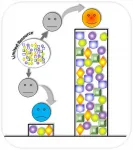(Press-News.org) SPOKANE, Wash. - Diabetic patients taking the natural product goldenseal while taking the prescription drug metformin may be unwittingly sabotaging their efforts to maintain healthy blood glucose levels. This concern arose from a recent study published in the journal Clinical Pharmacology & Therapeutics.
Metformin--the world's most-prescribed oral glucose-lowering medication--was included in a cocktail of selected drugs given to participants in a clinical study led by scientists at Washington State University's College of Pharmacy and Pharmaceutical Sciences. The study sought to determine the impact of goldenseal on specific drug transporters, proteins that facilitate absorption or expulsion of drug molecules in different tissues such as the intestine, liver and kidney.
"After six days of taking goldenseal, participants had about 25 percent less metformin in their bodies, a statistically significant change that could potentially impact glucose control in patients with type 2 diabetes," said the study's first author James Nguyen, a Ph.D. candidate in pharmaceutical sciences and recent Doctor of Pharmacy graduate. He said the finding serves as a caution to health care providers and patients that over-the-counter natural product use can lead to unwanted drug interactions, which may lead to negative health outcomes.
Unstable glucose levels increase patients' risk of serious health complications, such as heart disease, kidney disease and infections. Adding to that concern, Nguyen said there are reports that diabetic patients are increasingly using goldenseal and berberine--a substance found in goldenseal--to self-treat their condition, likely based on claims that berberine helps lower glucose levels.
A perennial herb native to North America, goldenseal is often combined with Echinacea, a top-selling botanical product, in herbal remedies used to self-treat the common cold and other respiratory tract infections. Goldenseal is also commonly used to self-treat digestive issues such as diarrhea and constipation as well as rashes and other skin problems.
Establishing Best Practices
Goldenseal is one of several natural products being studied by the researchers as part of the National Institutes of Health-funded Center of Excellence for Natural Product Drug Interaction Research, a WSU-led, multidisciplinary effort to develop standardized approaches for studying interactions between natural products and pharmaceutical drugs.
Senior author and center principal investigator Mary Paine--a professor in the WSU College of Pharmacy & Pharmaceutical Sciences--noted that while the Food and Drug Administration and other regulatory agencies have well-established guidelines for studying potential interactions between drugs, no such guidelines exist for natural product-drug interactions. This gap exists because, unlike drugs, natural products are not required to be tested for potential drug interaction risks prior to entering the market.
"Our work in this goldenseal study helps lay the foundation for establishing best practices for studying these interactions, with a particular niche in transporter-mediated interactions," Paine said.
Study Tests Model Predictions
One of the overarching goals of this recently published study was to determine whether established FDA basic mathematical models for predicting transporter-mediated drug-drug interactions could be used to successfully predict natural product-drug interactions. To find out, the researchers partnered with a contract research organization to conduct test tube experiments to determine whether a goldenseal extract inhibited any of 15 different transporters. Data from those experiments were then incorporated into the models to predict whether goldenseal interacts with any of the drugs included in a drug cocktail slated to be used in the subsequent clinical study. The cocktail included low doses of three different drugs known to be transported by various transporters: furosemide (a diuretic), rosuvastatin (an anti-cholesterol drug), and metformin. The drug midazolam (a short-acting sedative) was included in the cocktail as a positive control, or a drug known to interact with goldenseal. Goldenseal inhibits the metabolic enzyme that breaks down midazolam, leading to increased midazolam in the body.
Finally, they conducted a clinical study with 16 healthy participants to see if their predictions held up. Participants were given just the drug cocktail during the baseline phase. In the goldenseal exposure phase, participants took goldenseal three times daily for five days before being given the drug cocktail and another dose of goldenseal on day six, followed by two more doses later that day. Blood and urine samples were collected at regular intervals after participants took the drug cocktail and analyzed by the researchers to compare how each drug moved through the body with or without exposure to goldenseal.
Based on their model predictions, the researchers expected to find an interaction between goldenseal and rosuvastatin in the clinical study, but it did not materialize. Surprisingly, the clinical data showed that taking goldenseal along with metformin decreased metformin blood concentrations, which the model predictions did not reveal.
These findings will help the researchers refine these models to increase prediction accuracy of future natural product-drug interaction studies. As follow-up to the research, Nguyen plans to conduct studies to determine the mechanism by which goldenseal alters metformin absorption. Based on the data, he said that this appears to happen in the intestine and may be driven by the transporter OCT1. This research could eventually lead to the discovery of other natural product-drug interactions involving goldenseal and drugs transported by OCT1.
INFORMATION:
In addition to researchers at WSU, the team includes scientists from the University of North Carolina at Greensboro, the University of Washington, the University of Pittsburgh and SOLVO Biotechnology.
The study was funded by the National Center for Complementary and Integrative Health U54 Center Grant for Natural Product-Drug Interaction Research, U54-AT008909.
A new study by scientists at Utrecht University and the United Nations University concludes that about half of global wastewater is treated, rather than the previous estimate of 20%. Despite this promising finding, the authors warn that treatment rates in developing countries are still very low. The study and its dataset were published Open Access in the journal Earth System Science Data.
Humans and factories produce vast quantities of wastewater per day. If not properly collected and treated, wastewater may severely threaten human health and pollute the environment.
144 million swimming pools
The authors use national statistics to estimate volumes of wastewater production, collection, treatment and reuse. "Globally, about 359 ...
Faster speech rate, greater intensity in the middle of the word, and falling pitch at the end of the word: that is the prosody[1] to adopt if one wants to come across as reliable and honest to one's listeners. Scientists from the Science and Technology for Music and Sound laboratory (CNRS/Ircam/Sorbonne Université/Ministère de la Culture)[2] and the Perceptual Systems Laboratory (CNRS/ENS PSL) have conducted a series of experiments[3] to understand how we decide, based on the voice, whether a speaker is honest and confident, or on the contrary dishonest and uncertain. They have also shown that this signature was perceived similarly ...
The sense of hearing is, quite literally, a molecular tightrope act. Turns out, it involves acrobatics as well.
In a paper published in Nature Communications on Feb 8, researchers at Harvard Medical School and Boston Children's Hospital show that a dynamic and delicate connection between two pairs of diminutive protein filaments plays a central role in in hearing.
The tension held by these filaments, together called a tip link, is essential for the activation of sensory cells in the inner ear. The team's analyses reveal that the filaments, which are joined end-to-end, work together like trapeze artists holding ...
COVID-19 has not only caused a temporary drop in global CO2 emissions, it has also reduced the share of power generated by burning coal - a trend that could in fact outlast the pandemic. This is the key result of a new study by a team of economists based in Potsdam and Berlin that looked at COVID-19's impact on the energy system and demand for electricity. Their findings show that the pandemic, while putting a terrible toll on people's lives and the economy, has also opened a window of opportunity to make this current trend of decreasing coal use irreversible: Supported by the right climate policy measures, power sector emissions could decline more rapidly than previously thought.
"Coal has been hit harder by the Corona crisis than other power sources - and the reason is ...
Higher blood pressure at night than in daytime may be a risk factor for Alzheimer's disease in older men. This is suggested by a new study from researchers at Uppsala University, now published in the journal Hypertension.
'Dementia' is an umbrella term used to describe a category of symptoms marked by behavioural changes and gradually declining cognitive and social abilities. Numerous factors, including hypertension (high blood pressure), affect the risk of developing these symptoms.
Under healthy conditions, blood pressure (BP) varies over 24 hours, with lowest values reached at night. Doctors call this nocturnal blood pressure fall 'dipping'. However, in some people, ...
A new process for inserting synthetic gene circuits into host cells, developed by a team of bioengineers at Arizona State University, has broad implications for improving the effectiveness of a range of disease therapies.
Synthetic biology is an interdisciplinary research field that uses engineering principles to create biological components that don't exist in the natural world. These synthetic components mimic naturally evolved organisms, but are customized to fight disease, including cancer.
A paper recently published in Nature Communications, "Winner-Takes-All Resource Competition Redirects Cascading Cell Fate Transitions," outlines how gene circuits can be reconfigured so that they do not overwhelm the host cells.
"We ...
In the early months of the COVID-19 pandemic, there was an almost 80% decrease in primary care office visits in Ontario and a 56-fold increase in virtual visits, found new research in CMAJ (Canadian Medical Association Journal).
"Initial reports from primary care providers during the pandemic in both Canada and the United States showed major disruptions to care, decreased payments, challenges keeping offices functioning, lack of personal protective equipment and widespread uptake of virtual care, but we didn't know how COVID-19 had affected in-person office visits," says ...
People living in regions with high levels of outdoor artificial light at night may face a higher risk of developing thyroid cancer. The finding comes from a study published early online in END ...
A new national survey of more than 2,000 Americans by END ...
A method that instructs immune system cells to help repair damaged tissues in the intestine has been developed by researchers at KU Leuven and Seoul National University. This opens the way for more effective treatment of inflammatory bowel disease, including ulcerative colitis and Crohn's disease. The study was carried out on humans and mice.
When functioning correctly, the immune system protects against harmful agents such as bacteria that get into the body. But in conditions such as inflammatory bowel disease (IBD), the immune system attacks the tissues that line the gut, forming ulcers and causing pain and discomfort. Nearly 3.9 million women and 3.0 ...

